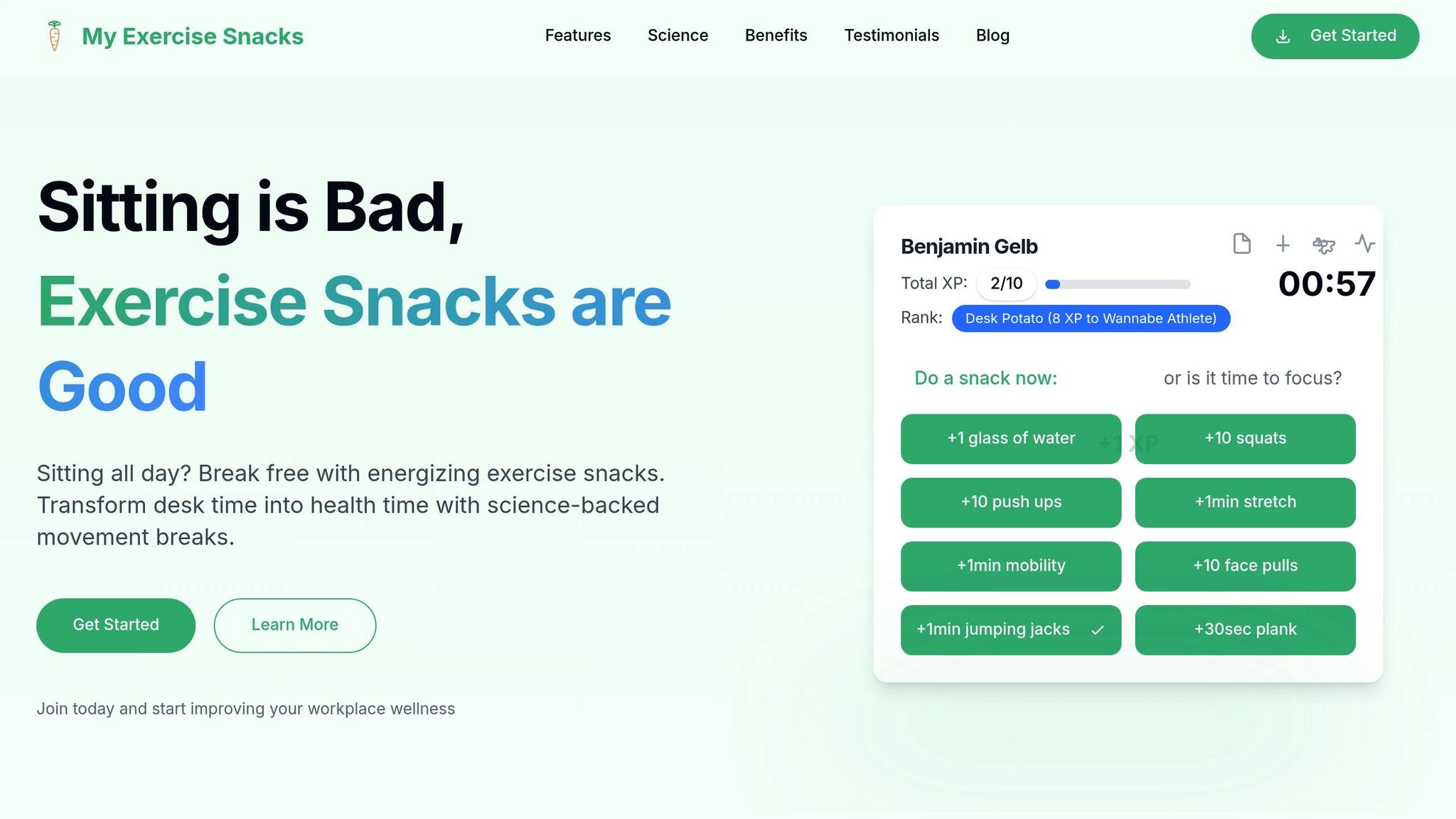
Physical Activity and Task Switching: Research Insights
Exercise can supercharge your brain. It improves task-switching, focus, and cognitive flexibility, making you more productive and less stressed. Research shows aerobic workouts boost brain regions like the prefrontal cortex and hippocampus, helping you adapt to new tasks faster. Here’s what you need to know:
- Immediate Benefits: A single 20-minute workout can sharpen focus, reduce reaction times, and improve task-switching by 58 milliseconds.
- Long-term Gains: Regular exercise lowers cognitive decline risk and enhances brain structure, like increasing gray matter.
- Best Activities: Open-skill exercises (e.g., badminton) boost brain-derived neurotrophic factor (BDNF) more than closed-skill activities (e.g., running).
- Quick Office Tips: Try desk-friendly moves like seated core tightening or standing desk transitions to stay sharp throughout the day.
Pro Tip: Follow the “20-8-2 rule” - sit for 20 minutes, stand for 8, and move for 2 - to stay focused and energized.
Incorporating even small movement breaks into your day can recharge your brain and productivity.
2 Minute ‘Focus Better’ Brain & Body Break
The Science Behind Movement and Task Switching
Exercise isn’t just good for the body - it works wonders for the brain too. Research shows that physical activity can sharpen your ability to switch between tasks effectively. How? By boosting activity in key brain regions, like the prefrontal cortex and hippocampus, which are vital for cognitive control. These findings build on earlier evidence that exercise improves focus and energy levels almost immediately.
Brain Changes During Task Switching
When it comes to task switching, exercise doesn’t just enhance performance - it actually changes the brain. Studies have pinpointed the specific areas of the brain that benefit. For example, research by Colcombe et al. revealed that aerobic fitness training in older adults increased gray matter in several critical regions and boosted white matter volume in the anterior third of the corpus callosum. This suggests better communication between different parts of the brain. The areas affected include:
- Frontal lobes
- Dorsal anterior cingulate cortex
- Supplementary motor area
- Middle frontal gyrus
- Right inferior frontal gyrus
- Left superior temporal lobe
“Aerobic fitness spares age-related loss of brain tissue during aging, and enhances functional aspects of higher order regions involved in the control of cognition.” – Fernando Gomez-Pinilla and Charles Hillman
Interestingly, the type of exercise you choose also matters. Open-skill activities like badminton, which require quick decision-making, lead to higher increases in brain-derived neurotrophic factor (BDNF) compared to closed-skill exercises like running. This suggests that dynamic, mentally engaging activities may offer additional cognitive perks.
Immediate vs. Long-term Benefits
The benefits of exercise for cognitive performance show up both right away and over the long run, though the effects differ depending on the timeframe:
{{table:eyJoZWFkZXJzIjpbIlRpbWVmcmFtZSIsIkJlbmVmaXRzIiwiUmVzZWFyY2ggRmluZGluZ3MiXSwicm93cyI6W1siSW1tZWRpYXRlIChTaW5nbGUgU2Vzc2lvbikiLCItIFNoYXJwZXIgY29nbml0aXZlIHBlcmZvcm1hbmNlICAtIEZhc3RlciByZWFjdGlvbiB0aW1lcyAgLSBJbXByb3ZlZCByZXNwb25zZSBpbmhpYml0aW9uIiwiNDMgc3R1ZGllcyBmb3VuZCBpbW1lZGlhdGUgaW1wcm92ZW1lbnRzIGluIGNvZ25pdGl2ZSB0YXNrcyBhbW9uZyB5b3VuZyBhZHVsdHMiXSxbIkxvbmctdGVybSAoUmVndWxhciBFeGVyY2lzZSkiLCItIExvd2VyIHJpc2sgb2YgY29nbml0aXZlIGRlY2xpbmUgIC0gU3RydWN0dXJhbCBicmFpbiBjaGFuZ2VzICAtIEJldHRlciBleGVjdXRpdmUgZnVuY3Rpb24iLCJJbmFjdGl2ZSBhZHVsdHMgZXhwZXJpZW5jZSBuZWFybHkgZG91YmxlIHRoZSByYXRlIG9mIGNvZ25pdGl2ZSBkZWNsaW5lIGNvbXBhcmVkIHRvIGFjdGl2ZSBpbmRpdmlkdWFscyJdXX0=}}
Exercise intensity also plays a role. Moderate-intensity workouts are great for improving working memory and mental flexibility, while high-intensity activities enhance information processing speed. For example, a 6-month walking intervention with 124 older adults showed significant gains in cognitive control compared to flexibility training alone.
To maximize cognitive benefits, a mix of exercises that build strength, endurance, balance, and coordination is ideal. The evidence is clear: incorporating regular physical activity into your routine can be a powerful way to enhance both brain function and productivity.
Office Movement Strategies That Work
Incorporating movement into your workday doesn’t require a gym membership or fancy equipment. By taking strategic movement breaks, you can improve your ability to switch tasks and boost productivity. Research shows that well-timed exercises can also enhance cognitive performance throughout the day.
Quick Exercises for Your Desk
Here are some simple, desk-friendly exercises that can help sharpen your focus and keep you energized:
{{table:eyJoZWFkZXJzIjpbIkV4ZXJjaXNlIFR5cGUiLCJNb3ZlbWVudCIsIkJlbmVmaXRzIl0sInJvd3MiOltbIkNvcmUgRW5nYWdlbWVudCIsIlNlYXRlZCBhYmRvbWluYWwgdGlnaHRlbmluZyAoMzAgc2VjKSIsIkltcHJvdmVzIHBvc3R1cmUgYW5kIGNvbmNlbnRyYXRpb24iXSxbIkxvd2VyIEJvZHkiLCJEZXNrIGxlZyBhbmQgY2FsZiByYWlzZXMiLCJFbmhhbmNlcyBibG9vZCBmbG93IGFuZCBhbGVydG5lc3MiXSxbIlVwcGVyIEJvZHkiLCJTaG91bGRlciByb2xscywgYXJtIGNpcmNsZXMiLCJSZWR1Y2VzIHRlbnNpb24gYW5kIGluY3JlYXNlcyBlbmVyZ3kiXSxbIkZ1bGwgQm9keSIsIlN0YW5kaW5nIGRlc2sgdHJhbnNpdGlvbnMiLCJBY3RpdmF0ZXMgbXVsdGlwbGUgbXVzY2xlIGdyb3VwcyJdXX0=}}
For added effectiveness, try incorporating resistance bands or small hand weights. Swapping your office chair for a stability ball can also help maintain good posture while engaging your core muscles.
When to Take Movement Breaks
Timing is everything when it comes to maximizing the benefits of movement breaks. Professor Alejandro Lleras highlights the importance of brief pauses to maintain focus:
“We propose that deactivating and reactivating your goals allows you to stay focused. From a practical standpoint, our research suggests that, when faced with long tasks (such as studying before a final exam or doing your taxes), it is best to impose brief breaks on yourself. Brief mental breaks will actually help you stay focused on your task!”
A good rule of thumb is to follow the “20-8-2 rule”: spend 20 minutes sitting, 8 minutes standing, and 2 minutes moving. Another approach, often used by high achievers, involves working in focused 52-minute intervals followed by 17-minute breaks.
Using My Exercise Snacks at Work

The My Exercise Snacks platform takes these research-backed strategies and turns them into actionable tools for workplace wellness. It offers a library of desk-friendly exercises designed to sharpen focus and improve overall health. Detailed form guidance ensures these movements are suitable for professional environments, and a gamified streak system - complete with XP and fitness ranks - keeps users motivated.
To align with natural concentration rhythms, set reminders to move every 30-60 minutes. These regular breaks not only refresh your mind but also combat the health risks of prolonged sitting, a problem that contributes to $24.7 billion in global healthcare costs.
Research on Exercise Amount and Results
Research consistently shows a strong connection between regular exercise and improved cognitive abilities, particularly in task-switching. While even modest levels of physical activity can yield mental benefits, the ideal amount and type of exercise depend on individual factors.
Required Exercise for Brain Benefits
Engaging in just 20 minutes of moderate aerobic exercise (at 80% of your maximum heart rate) can significantly enhance task-switching efficiency. For example, individuals with higher fitness levels showed a 58-millisecond improvement in task-switching after a 30-minute workout session.
The benefits also vary based on the type and intensity of exercise. A study comparing different exercise protocols revealed the following:
{{table:eyJoZWFkZXJzIjpbIkV4ZXJjaXNlIFR5cGUiLCJEdXJhdGlvbiIsIkNvZ25pdGl2ZSBCZW5lZml0cyJdLCJyb3dzIjpbWyJIaWdoLUludGVuc2l0eSBJbnRlcnZhbCBFeGVyY2lzZSAoSElJRSkiLCIyMCBtaW51dGVzIiwiQm9vc3RlZCBjb2duaXRpdmUgZmxleGliaWxpdHksIGVzcGVjaWFsbHkgZm9yIGluZGl2aWR1YWxzIHdpdGggc3Ryb25nZXIgYmFzZWxpbmUgcGVyZm9ybWFuY2UiXSxbIk1vZGVyYXRlLUludGVuc2l0eSBDb250aW51b3VzIEV4ZXJjaXNlIChNSUNFKSIsIjIwIG1pbnV0ZXMiLCJFbmhhbmNlZCBwZXJmb3JtYW5jZSwgcGFydGljdWxhcmx5IGZvciB0aG9zZSBzdGFydGluZyB3aXRoIGxvd2VyIGNvZ25pdGl2ZSBhYmlsaXR5Il0sWyJIaWdoLUludGVuc2l0eSBJbnRlcnZhbCBUcmFpbmluZyAoSElJVCkiLCIyw5cyMCBtaW51dGVzIiwiUmVkdWNlZCByZWFjdGlvbiB0aW1lcyBpbiBvbGRlciBhZHVsdHMsIGltcHJvdmluZyBmcm9tIDEsMjUwIHRvIDEsMTAwIG1pbGxpc2Vjb25kcyJdXX0=}}
These findings emphasize the importance of both the type and duration of exercise in achieving cognitive benefits.
Finding the Right Exercise Balance
Striking the right balance between intensity, duration, and frequency is key to maximizing cognitive gains. Research also highlights how timing and frequency of activity can influence productivity and focus:
- Frequent task-switching can lower productivity by up to 40%.
- On average, it takes 64 seconds to refocus after an interruption.
- Excessive task-switching may waste up to 10% of working hours.
Here are some practical, research-supported tips to optimize your exercise routine for mental benefits:
- Intensity Counts: High-intensity interval training (HIIT) often delivers greater improvements in cognitive flexibility compared to moderate-intensity workouts.
- Find the Ideal Duration: Moderate-intensity sessions lasting 20–30 minutes are particularly effective for immediate cognitive benefits.
- Strategize Frequency: Incorporate regular movement breaks to counteract the negative effects of over-switching tasks.
Personalization is key. High-fit individuals may benefit from longer, more intense sessions, while moderate activity might be more effective for those with lower fitness levels. Additionally, engaging in open-skill activities like badminton or table tennis for 30 minutes, three times a week, can further enhance cognitive flexibility.
Conclusion: Movement as a Work Performance Tool
Research consistently highlights how exercise boosts brain function and enhances our ability to switch between tasks. Studies confirm that physical activity improves cognitive flexibility, mental sharpness, and overall work performance. Even short sessions of exercise can lead to noticeable improvements in these areas.
“More active or higher fit individuals are capable of allocating greater attentional resources toward the environment and are able to process information more quickly”
The business case for encouraging movement in the workplace is hard to ignore:
- 91% of companies report lower healthcare costs
- 99% of HR leaders observe improved employee productivity
- Employees exercising 5+ times monthly reduce company healthcare costs by 35% within a year
These numbers make it clear: the cognitive benefits of regular movement translate directly into tangible workplace gains. Both high-intensity interval exercise (HIIE) and moderate-intensity continuous exercise (MICE) - even just 20-minute sessions - have been shown to enhance working memory and cognitive flexibility.
“When employees are physically active, it not only benefits their physical health but also improves their mental health, resulting in increased productivity and reduced levels of burnout and turnover”
Incorporating movement into your workday doesn’t have to be complicated. Here are a few simple strategies:
- Turn traditional meetings into walking meetings.
- Use standing desks paired with light walking pads.
- Take short stretch breaks between tasks.
- Join or organize workplace fitness challenges.
FAQs
How do open-skill exercises like badminton improve cognitive flexibility compared to closed-skill exercises like running?
Open-skill activities like badminton have been shown to boost cognitive flexibility more effectively than closed-skill exercises such as running. Why? Because open-skill exercises demand quick thinking and the ability to adapt to constantly changing situations. This sharpens mental agility and strengthens key executive functions like working memory and attention.
On the other hand, closed-skill exercises are great for improving focus and self-control, but they don’t challenge the brain in the same way. Incorporating open-skill activities into your routine can be an excellent way to enhance mental adaptability and support overall brain health.
How can I add simple movement breaks to my workday to boost productivity?
Taking short movement breaks during your workday can do wonders for your focus, lower stress, and even give your productivity a noticeable lift. Here are some simple ways to work these breaks into your routine:
- Set reminders on your phone or computer to stand up, stretch, or move around every 30–60 minutes.
- Swap out traditional meetings for walking meetings - a great way to stay active while discussing ideas.
- Use apps or tools to guide you through quick, desk-friendly exercises during the day.
- Designate a small area in your workspace for stretching or light activities to recharge.
Even brief moments of movement can significantly boost your energy and sharpen your thinking. Turning these breaks into a daily habit can help create a healthier, more efficient workday.
How can balancing exercise intensity, duration, and frequency improve cognitive performance?
Balancing exercise intensity, duration, and frequency plays a crucial role in boosting cognitive performance, as each element impacts the brain in unique ways. For instance, moderate-intensity workouts are often associated with improvements in memory and cognitive flexibility. On the other hand, high-intensity exercises can sharpen focus and decision-making skills, though pushing too hard might lead to fatigue.
Studies show that sticking to a regular schedule - like aiming for 150 minutes of moderate exercise per week - delivers better results for cognitive function than sporadic bursts of intense activity. Finding a routine that matches your personal needs can help enhance brain health and keep you performing at your best, whether at work or in daily life.
